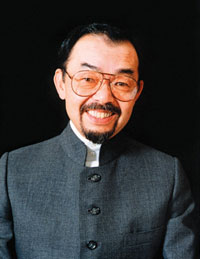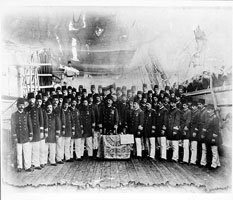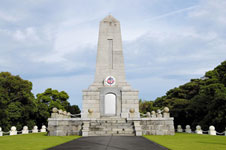Ocean Newsletter
No.178 January 5, 2008
-
Paragons of Private Diplomacy -- A Friendship Borne of the Ocean --
His Highness Imperial Prince TomohitoProfessor, School of Marine Science and Technology, Tokai University
In the 22nd year of the Meiji era (1889) the Ertuğrul disaster at sea occurred when the Ottoman Navy Frigate sank off the coast of Kashinozaki, in Kushimoto Village, Wakayama Prefecture. The rescue efforts in the midst of a raging typhoon by the fisher-folk of Kashinozaki and the later care extended to the survivors is considered the starting point of Japanese-Turkish friendship. This bond between the two peoples, difficult to put into words, has not been forgotten over the years, but has if anything grown stronger. We can see the ideal of private diplomacy embodied in this heartwarming story, which deserves to be passed on to future generations.
-
Are Current Maritime Security Initiatives Sufficient? - Thoughts on piracy off the Somalia coast -
Masahiro Akiyama Chairman, Ocean Policy Research Foundation
In recent years, there have been many attacks on merchant and fishing vessels off the coast of Somalia. As these waters linking the Suez Canal and Indian Ocean are of great strategic importance on the route in the Middle East, the incidents can by no means be ignored by Japan. In light of the fact that threats to the safety of maritime transport impinge on our nation's very survival, we must ask if our current maritime security initiatives are indeed sufficient.
-
On Becoming a Strategically Important Maritime State
Itsunori Onodera Senior Vice-Minister for Foreign Affairs, Member of Parliament, LDP
As all of Japan's borders are on the ocean, most Japanese can go about their lives without ever being conscious of them. However, with the increase of its ocean areas due to its EEZ the shape of the country has changed, so that it now shares borders with seven countries. An international ocean strategy is thus called for, in which we can share ideas with our neighbors to bring about the fruits of economic growth and peace in the region.
Paragons of Private Diplomacy — A Friendship Borne of the Ocean —
ABSTRACT

In the 22nd year of the Meiji era (1889) the Ertu?rul disaster at sea occurred when the Ottoman Navy Frigate sank off the coast of Kashinozaki, in Kushimoto Village, Wakayama Prefecture. The rescue efforts in the midst of a raging typhoon by the fisher-folk of Kashinozaki and the later care extended to the survivors is considered the starting point of Japanese-Turkish friendship. This bond between the two peoples, difficult to put into words, has not been forgotten over the years, but has if anything grown stronger. We can see the ideal of private diplomacy embodied in this heartwarming story, which deserves to be passed on to future generations.
The Ertu?rul Disaster
In the 21st year of the Meiji era (1988), Japanese emperor Meiji presented the Turkish Emperor Abdul Hamit II with the Collar of the Supreme Order of the Chrysanthemum and many other rare gifts from Japan. In return, the following year the Ertu?rul left for Japan commanded by Admiral Osman Pasha and bearing the Ottoman empire’s highest honors and gifts for the Emperor Meiji.
The admiral reached Japan without incident and after discharging all of his duties was about to set out for home when for reasons still unknown he decided to delay his departure by one month. This delay caused the Ertu?rul, a wooden frigate, to sail directly into a typhoon off the coast of Wakayama prefecture, where it sank after running into the reefs near Kashinozaki, Kushimoto Village.
Of the 609 people on board the Ertu?rul that day, 540 lost their lives, with the other 69 surviving only through the desperate rescue efforts of the Kashinozaki fisher-folk. Word of the tragic accident was immediately sent to the Emperor Meiji and others in Tokyo.
After their immediate needs were attended to, the survivors were then cared for largely by representatives of the government, but a relief campaign was also begun by a private citizen, YAMADA Torajiro, the descendant of one of the chief retainers of the fief of Numata, in Joushu. Yamada called upon KUGA Katsunan and FUKUMOTO Nichinan, editors of the famous Meiji era newspaper Nippon, who helped in soliciting contributions nationwide. Although such relief campaigns are fairly common these days, this large-scale effort was likely the first of its kind in the early Meiji era and raised 5,000 yen, or roughly 30 million yen in today’s money.
Deeply saddened by the loss of life and sinking of the Ertu?rul, which had undertaken the long journey expressly for him, the Emperor Meiji ordered the royal ships Kong? and Hiei to conduct the 69 survivors back safely to their home.
 The Ertu?rul at anchor in the Bosporus Straits
The Ertu?rul at anchor in the Bosporus Straits
 The crew of the Ertu?rul.
The crew of the Ertu?rul.
From Relief Efforts to Private Diplomacy
The people of Turkey were deeply moved by the prompt and generous relief efforts of this group of Japanese, and have since declared the year of the accident, 1890 (Meiji 23), to be the beginning of the Turkey-Japan Friendship. In 1990 (Heisei 2), memorial services and ceremonies were held simultaneously in both countries on September 16th to mark the 100th anniversary of the incident.
On the occasion of these ceremonies, which I attended on behalf of my father, I paid a visit to the naval port of Mersin. As the ceremony was drawing to a close and I was to pass in front of the Honor Guard I gave out the traditional Turkish salutation, “Merhaba Asker!” (Greetings, Soldiers!), to which they immediately responded, “Sadol!”(Thank you, Sir; or, to your health). To this, in turn, I shouted out a final greeting of “Siz'de sag olsun” (To your health and long life!), for which I was later thanked by the local people, who explained that very few take the trouble to make the final greeting.
Just after this, I walked to the end of the pier and into a cavern-like building where I was asked to sign my name in a large guest book. I first wrote my name and title in Japanese characters and then, in large letters, TOMOHITO. Giving the pen to my wife, I then looked up towards the wall and saw enshrined on a beautiful glass shelf two flasks, one of water and the other of earth. I immediately enquired as to their meaning and was told, “They are the water and soil of Kashinozaki, enshrined here so that we may never forget the selfless and heartwarming rescue efforts of those fisher-folk.”
I was suddenly deeply moved, as it occurred to me, that the greatest example of private diplomacy is to be found in these two flasks.
The facts of the incident though are straightforward. The rescued seamen understood no Japanese and the Kashinozaki fishermen and their families most likely had never even laid eyes on a foreigner before that day. And yet, they scrambled frantically up and down sheer cliffs to save these 69 men from a foreign land. The local people no doubt shouted to the men in their local Wakayama dialect, but not being understood could only use gestures to communicate with the flailing seamen, while the typhoon raged around them.
I was deeply moved at seeing for myself this bond, inexpressible in words, but born as two peoples, strangers to each other, struggled to snatch life out of the jaws of death. Although taking place more than one hundred years ago, the bond only grows stronger.
As we left in the car, the Imperial Palace Police Escort who was with me, Captain SAEKI Taketaka, a fine skier who has often accompanied me over the years, was also moved and said to me, “Your highness, at the beginning of my career, when we would receive training at the police university, we all slept in a big room together. At night, after a few drinks, a fellow officer from Wakayama would always stand up and recite, ‘Wakayama has a proud history. It was our ancestors that came to the aid of the Turks.’At the time it made no sense to me so I ignored it. Now I understand.”
I told him in response that he should look in the rolls from that time and write to the man from Wakayama. He would be happy to know that the private diplomacy of his ancestors has borne great fruit in the relations between the two countries.
Private Diplomacy Continues
 The memorial tower for the Ertu?rul at Kushimoto Village.
The memorial tower for the Ertu?rul at Kushimoto Village.
There is also a moving sequel to the Ertu?rul story. It was at the time of the Iran-Iraq war, the terrible conflict lasting 6 years that took place before the present Iraq war and the Persian Gulf war before that.
At the beginning of the war, when 215 Japanese found themselves in Teheran with no way to return home, President Ozal of the Republic of Turkey ordered the state carrier Turkey Airlines to evacuate the stranded Japanese, no matter the danger.
With many other nationalities stranded as well, Turkish Airlines was no doubt put in a difficult situation by boarding only the Japanese, but in the end they arrived safely onto Turkish territory. When the plane neared Istanbul airport, cheers of “Banzai!”, “Banzai!” arose from the passengers, who had sat stunned after their long ordeal.
Looked at poetically, this might be seen as simply returning in the air the good deed you received at sea, but most people associate diplomacy only with the Foreign Ministry and diplomats, the Prime Minister and his cabinet, or business and academic leaders.
The Ertu?rul disaster and rescue by the fisherfolk of Kashinozaki, along with the successful evacuation ordered by the pro-Japan President Ozal that was carried out by the brave pilots and flight crew of Turkish Airlines, are two wonderful stories that show the best that private diplomacy can accomplish. It is our duty to ensure that accounts of these deeds are passed on to future generations.
All three photographs provided by the Middle Eastern Culture Center in Japan’s museum.
